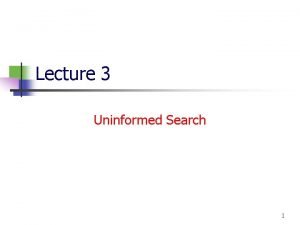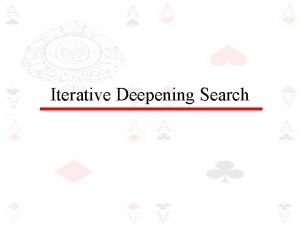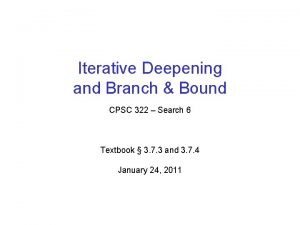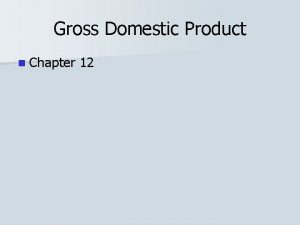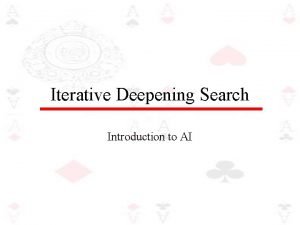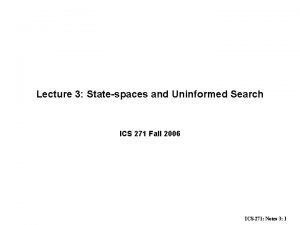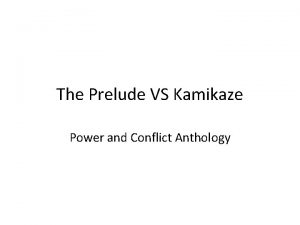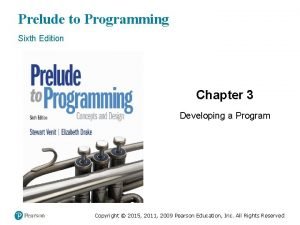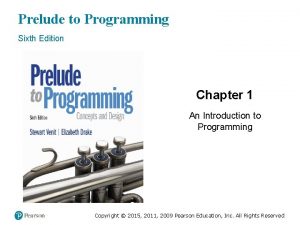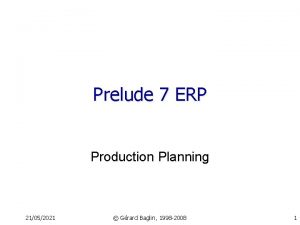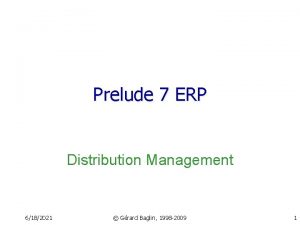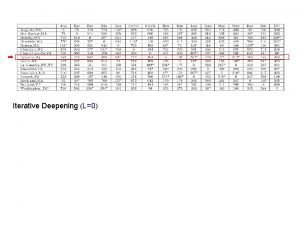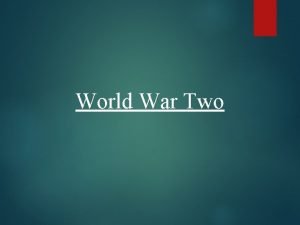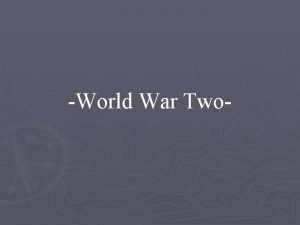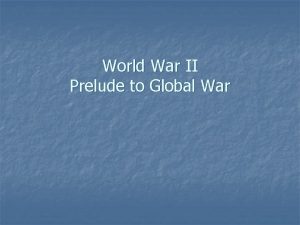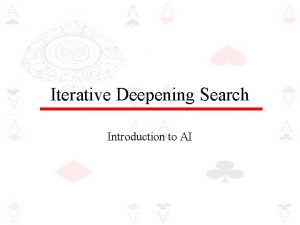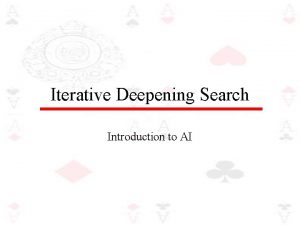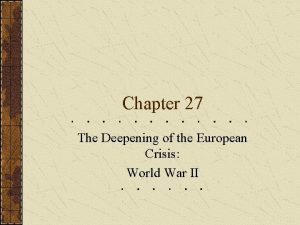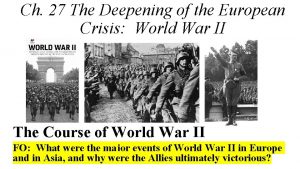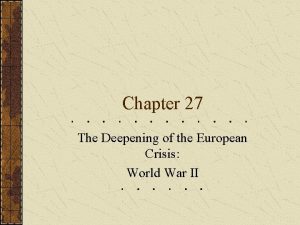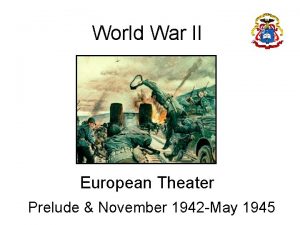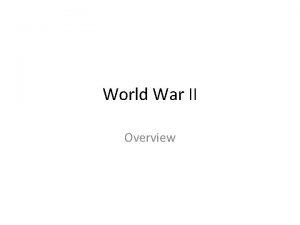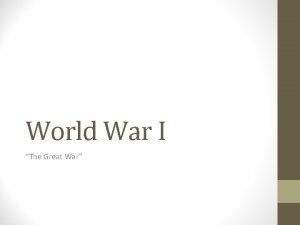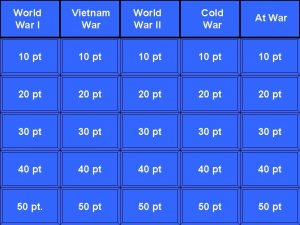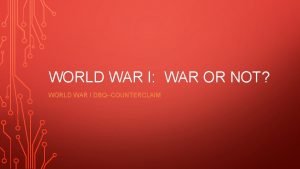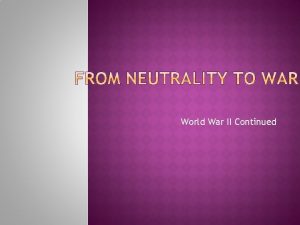The Deepening European Crisis World War II Prelude



































- Slides: 35

The Deepening European Crisis: World War II

Prelude to War: Major Trends ¡ By 1930 s, peace-keeping strategies had largely failed l l l l ¡ collective security abandoned disarmament plans failed WWI peace treaties all seemed to be in the toilet GB and France wanted nothing to do with another war US into isolationism New states too weak to oppose Germany Soviets were excluded from European affairs Germany was poised to make a move!

Prelude to War: Hitler’s Role ¡ Hitler embraces Haushofer’s doctrine of Lebensraum l l ¡ ¡ Seize land to the East from “inferior” Slavs Many German conservatives supported this This meant war with Soviets Hitler pursued this policy to a much greater extent than conservatives had intended…

Prelude to War: “Diplomatic Revolution” (1933 -1937) ¡ ¡ ¡ ¡ Hitler becomes chancellor, January 30, 1933 Germany withdraws from Geneva Disarmament Conference and the League of Nations for “independence” from Europe Slow rearmament for sake of “peace” Repudiation of disarmament clauses of Versailles Peace Treaty, 1935: nobody challenges it! GB pushes for “APPEASEMENT” (anti-USSR motive) 6/18/1935: Anglo-German Naval Pact Troops into the demilitarized Rhineland, March 7, 1936 (“going into their own back garden…”) New Allies: l Rome-Berlin Axis, October 1936 due to Ethiopia invasion (Italy needs new friends!) l Anti-Comintern Pact between Germany and Japan, November 1936 against Communism

Adolph Hitler & Benito Mussolini in Munich, Germany, June 1940 GB and France are mad at us over Ethiopia, Adolph. Will you be our friend? Sure, Buffoon…er, I mean Benny!

Changes in Central Europe, 19361939

The Path to War (1938 -1939): Anschluss 3/13/1938 11/5/37 – Hitler reveals ultimate goal: living space in the east and Austria is first! ¡ Hitler threatens Austrian chancellor Kurt von Schuschnigg with invasion l Kurt attempts to have Austrians vote in plebiscite in 3/13 on German takeover l undermined by Wehrmacht invasion 3/12. ¡ Austrian Nazis to take over! ¡ 24 hours later, 3/13/1938, Austria formally annexed by Germany (Anschluss) ¡ GB and France do nothing! ¡

The Path to War (1938 -1939): Sudetenland, 9/15/38 ¡ ¡ With Czechoslovakia almost surrounded, Germans put squeeze on them Demands the cession of the Sudetenland, September 15, 1938 l l l ¡ ¡ Munich Conference, 9/29/38 Neville Chamberlain (1869 -1940) Prime Minister of GB l l Chamberlain and Hitler l ¡ ¡ Home to many ethnic Germans A major industrial region Initially asks for independence from Czechs, eventually demands that Germans take control, 9/15/38 Appeasement “Peace for our Time” Churchill’s opposing viewpoint By 1939, Germans take Bohemia and Moravia too! German dismemberment of Czechoslovakia provokes suspicion…

The Path to War (1938 -1939): ¡ Hitler demands Danzig (Gdansk) l l ¡ ¡ ¡ Allegedly a “free” port city British offer to protect Poland Non-aggression pact with the Soviet Union, August 23, 1939 (Molotov. Ribbentrop Pact) Invasion of Poland, September 1, 1939 Britain and France declare war on Germany, September 3, 1939

The Path to War in Asia Japanese Aggression ¡ ¡ ¡ ¡ ¡ Depression caused economic and then political conflict in Japan. Belief that Japan must be self-sufficient and not rely on trade with foreigners to survive! Built up army and navy, and then moved in on European holdings in Asia, angering many. China, Korea, Formosa, and the Marshall, Caroline, and Mariana islands were all targets 1931 Japan seized Manchuria 1937 Japan invades China l Chiang Kai-shek of China resists Japanese aggression l China later becomes an ally of the US US refuses to sell scrap iron and oil in protest of Japan taking Indochina (French) Japan bombs Pearl Harbor 12/7/1941 US declares war on Japan 12/8/41 Hitler declares war on US 12/11/41

Japanese Empire, 1942

The Course to World War II ¡ ¡ ¡ Blitzkrieg (lightening war) overwhelms Poland divided on September 28, 1939 Victory and Stalemate l l l l Allied “defensive” stance and the Maginot Line “Phony War”, winter 1939 -1940: not much happening Germany resumes offensive, April 9, 1939, against Denmark and Norway (Springtime for Hitler) Attack on Netherlands, Belgium, and France, May 10, 1940 Evacuation of Dunkirk (“Miracle at Dunkirk” – 300 k) Surrender of France, June 22, 1940 Vichy France ¡ ¡ Marshal Henri Pétain (1856 -1951) Battle of Britain, August-September 1940 l l l Churchill’s hardcore stance… German shift to civilian targets German Luftwaffe

The Course to World War II ¡ German Mediterranean strategy l l ¡ Take Suez Canal – cut off supply of oil Depends on Italy’s ability to hold off British in Africa – no luck! New Plan: Germany invades the Soviet Union, June 22, 1941 l l Initial German success Soviets able to bring eastern front troops to west as Japan was busy with the U. S. in 12/41 Extra troops and early winter turn tide in favor of Soviets Hitler’s declaration of war on U. S. helps to seal Germany’s fate…

© 2003 Wadsworth, a division of Thomson Learning, Inc. Thomson Learning™ is a trademark used herein under license. World War II in Europe & North Africa

The War in Asia ¡ ¡ ¡ Pearl Harbor 12/7/1941 Assault on the Philippines, 1941 US, Britain and China declare war on Japan 12/8 and 12/9 Bataan Death March, Philippines, 1942 Attacks galvanized American opinion in support for war Japan initially sees victory through 1942

Explosion of the U. S. S. Shaw during attack on Pearl Harbor December 7, 1941

© 2003 Wadsworth, a division of Thomson Learning, Inc. Thomson Learning™ is a trademark used herein under license. World War II in Asia & the Pacific

Turning Point of War, 1942 -1943 ¡ The Grand Alliance: US, GB, USSR l l ¡ Defeat of Germany the first priority Military aid to Russia and Britain Allies ignore political differences Agree on unconditional surrender German success in 1942 in Africa and Soviet Union starts falling apart… l Allies invade North Africa, November 1942, victory in May 1943 Rommel stopped at El Alamein Battle of Stalingrad, November 1942 February 1943 – surrender at Tunisia & Allied victory War in Asia: Tide turns to favor Allies l ¡ l l Battle of the Coral Sea, May 7 -8, 1942 Battle of Midway, June 4, 1942

Last Years of the War ¡ Going after the “soft underbelly” l l l ¡ ¡ ¡ Invasion of Sicily, 1943 Invasion of Italy, September 1943 Rome falls June 4, 1944 D-Day invasion of France, June 6, 1944 l Five assault divisions landed on Normandy beaches l Within three months, two million men landed l Battle of the Bulge German surrender at Stalingrad, February 2, 1943 Tank Battle of Kursk, Soviet Union, July 5 -12, 1943: 18 Panzer divisions wiped out!

D-Day Invasion

Last Years of the War (cont) ¡ ¡ ¡ ¡ ¡ Mussolini’s corpse on display Russians enter Berlin, April 1945 Mussolini’s body dragged through Rome Death of President Franklin Roosevelt, April 12, 1945 Hitler’s suicide, April 30, 1945 Surrender of Germany, May 7, 1945 Difficulty of invading the Japanese homeland New President Harry Truman makes decision to use the atomic bomb on Hiroshima and Nagasaki Surrender of Japan, August 14, 1945 Human losses in the war: 17 million military dead, 18 million civilians dead

The Nazi New Order ¡ Nazi occupies Europe was organized in two ways l l ¡ ¡ Racial considerations: those considered “Aryan” were treated with lenience (Norway, Netherlands, Denmark) Resettlement plans of the East l l Prototypes for superior racial groups vs. inferior ones ¡ ¡ Some areas annexed and made into German provinces Most areas were occupied and administered by Germans Poles were uprooted and moved 2 million ethnic Germans settled Poland, 1942 Need for labor: exploitation of conquered people By 1944, 20% of German workforce was foreign!

The Nazi Empire, 1942

Resistance Movements ¡ Charles de Gaulle l l ¡ Communist Josip Broz (“Tito”) in Yugoslavia l l ¡ Free French movement Against Communist liberation groups Anti-Fascist Council of National Liberation of Yugoslavia (AVNOJ) Communist leader who later broke with Stalin and the Soviet bloc In Germany l l The White Rose movement and Sophie Scholl Gestapo executes all involved students Colonel Count Claus von Stauffenberg assassination attempt ¡ Operation Valkyrie ¡ Five thousand executions

The Holocaust ¡ ¡ First focused on emigration: Madagascar Plan Initial efforts to confine and exterminate Jews l l Reinhard Heydrich (1904 -1942) Einsatzgrupen ¡ ¡ Final Solution: Wannsee Conference 1/20/42 Death camps l l l ¡ confine Jews to ghettos begin policy of shooting large groups: too difficult In operation by the spring of 1942 Shipments of Jews from Poland, France, Belgium, the Netherlands Berlin, Vienna, Prague, Greece, southern France, Italy, and Denmark Zyklon B (hydrogen cyanide): modeled after T-4 Program Auschwitz and Rudolf Hoess (Hess) 2/3 European Jews Killed The Other Holocaust l l Death of 9 - 10 million people beyond the 5 - 6 million Jews 40 percent of European Gypsies, Homosexuals

Learning™ is a trademark used herein under license. © 2003 Wadsworth, a division of Thomson Learning, Inc. Thomson The Holocaust

The New Order in Asia ¡ Great East Asia Co-Prosperity Sphere l l ¡ “Asia for the Asians” Propaganda to convince Asians in occupied territory to allow for Japanese exploitation Japanese Occupation l l Conquest of Nanjing “Comfort women” ¡ ¡ l l Served 15 -20 soldiers/day 10, 000 - 200, 000 are estimated to have been procured majority were from Korea and China used in "comfort stations" for Japanese military 800, 000 Korean forced laborers Burma-Thailand Railroads: ¡ ¡ Allied POWs and Asian forced labor - worked to death 12, 400 Allied POWs dead; 100, 000 Asian

The Mobilization of Peoples ¡ Great Britain l l ¡ 55 percent of the people were in ‘‘war work” By 1944, women held 50 percent of the civil service positions Dig for Victory Emphasis on a planned economy The Soviet Union l l l “Great Patriotic War” Enormous losses, 2 of every 5 killed in World War II were Russians Supercentralization “Battle for Machines” Factories moved to the interior when Germans advanced Starvation

The Mobilization of Peoples (cont) ¡ The United States l l Slow mobilization until mid-1943 Social problems ¡ ¡ ¡ l ¡ Japanese Americans in concentration camps Germany l l ¡ FDR: No racial discrimination in defense industries Movement of African Americans north for jobs: racial tension Detroit Race Riots, June 1943 Continued production of consumer goods first two years of the war Blitzkrieg and then plunder conquered countries Albert Speer and armaments production: wanted more humane treatment in factories Total mobilization of the economy, 1944: too little too late! Japan l l l Highly mobilized society Bushido “the way of the warrior” from Samurai tradition Kamikaze – modern take on Bushido

Civilians on the Front Line: The Bombing of Cities ¡ ¡ ¡ Bombing civilians: Giulio Douhet Luftwaffe begin the Blitz in Britain Allies begin bombing raids on German cities l l l ¡ ¡ Cologne, Germany Later in Hamburg and Dresden Massive firestorms Bombing civilians did not break the Brits or the Germans Atomic bomb l l Hiroshima, August 6, 1945 Nagasaki, August 9, 1945

Hiroshima after the atomic bomb, August 6, 1945 Clip from Hiroshima, Mon Amour part 1 And part 2

Aftermath: The Emergence of the Cold War ¡ ¡ Big Three: Stalin, Churchill, Roosevelt The Conferences at Teheran, Yalta, and Potsdam l Conference at Tehran, November 1943 ¡ ¡ ¡ l l Meeting at Moscow: “Spheres of Influence” on a scrap of paper…Churchill and Stalin Conference at Yalta, February 1945 ¡ ¡ ¡ l ¡ ¡ “Declaration on Liberated Europe” Soviet military assistance for the war against Japan Creation of a United Nations German unconditional surrender Free elections in Eastern Europe Conference at Potsdam, July 1945 ¡ ¡ Future course of the war, invasion of the continent for 1944 Agreement for the partition of postwar Germany Churchill’s approach through Balkans overruled: Soviets liberate E. Europe. Truman replaces Roosevelt Growing problems between the Allies Winston Churchill proclaims in March 1946 the existence of “an iron curtain” across the continent of Europe Cold War begins…

© 2003 Wadsworth, a division of Thomson Learning, Inc. Thomson Learning™ is a trademark used herein under license. Territorial Changes after World War II

Discussion Questions ¡ ¡ ¡ What steps did Hitler take to conquer England? Why did abandon the fight for England turn toward Russia? What seemed to have been the causes of Soviet suspicions about Britain and the US throughout the war? Give examples. How were conquered or occupied peoples treated by the Germans during the war? Give examples. How did each country mobilize the home front for the war effort?

Web Links ¡ ¡ ¡ ¡ ¡ Neville Chamberlain Invasion of Manchuria 1931 Chiang Kai-shek Blitzkrieg Battle of Leningrad Battle of Coral Seas Holocaust Hiroshima Potsdam Conference
 Gravis grave
Gravis grave Deepening understanding year 4
Deepening understanding year 4 Deepening understanding
Deepening understanding What is the aggregate production function
What is the aggregate production function Iterative deepening a* search
Iterative deepening a* search Geometric iterative deepening search
Geometric iterative deepening search Iterative deepening search example
Iterative deepening search example The sting movie
The sting movie Calculate gdp expenditure approach
Calculate gdp expenditure approach Capital deepening
Capital deepening Iterative deepening a* search
Iterative deepening a* search What is iterative deepening in ai
What is iterative deepening in ai Planted
Planted Deepening understanding year 5
Deepening understanding year 5 Depth first search algorithm complexity
Depth first search algorithm complexity Iterative deepening search
Iterative deepening search Iterative deepening search prolog
Iterative deepening search prolog Deepening understanding year 6
Deepening understanding year 6 Deepening understanding year 5
Deepening understanding year 5 European war 1
European war 1 Kamikaze power of nature
Kamikaze power of nature The stolen boat by william wordsworth summary
The stolen boat by william wordsworth summary Prelude to programming 6th edition
Prelude to programming 6th edition Prelude to programming 6th edition
Prelude to programming 6th edition Prelude 7 erp
Prelude 7 erp Prelude erp
Prelude erp Extract from the prelude poem
Extract from the prelude poem Extract from the prelude quotes
Extract from the prelude quotes E-prelude.com
E-prelude.com E-prelude.com
E-prelude.com Excerpt from the prelude
Excerpt from the prelude Storm on the island and prelude comparison
Storm on the island and prelude comparison Sequential circuits prelude
Sequential circuits prelude Maurane sur un prélude de bach analyse
Maurane sur un prélude de bach analyse Linux ids
Linux ids Prelude to programming 6th edition
Prelude to programming 6th edition




